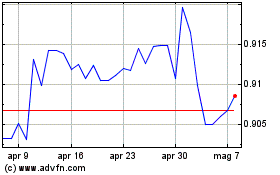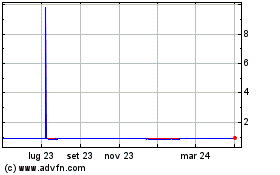Antipodean Currencies Fall Amid Risk Aversion
19 Luglio 2024 - 5:44AM
RTTF2
The Antipodean currencies such as the Australia and the New
Zealand dollars weakened against their major currencies in the
Asian session on Friday amid risk aversion, following the broadly
negative cues from Wall Street overnight, as most currencies in the
region weakened against the U.S. dollar on economic concerns amid
prospects of the U.S. administration imposing tougher sanctions on
firms exporting critical chipmaking equipment to China and
suggestions of Taiwan being asked to pay the U.S. for defense.
U.S. election jitters may also keep investors on the sidelines,
with President Joe Biden reportedly facing increased pressure from
senior democratic leaders to pull out of his re-election bid.
Weakness across most sectors led by mining and technology
stocks, also led to downturn of the investor sentiment.
Crude oil prices eased slightly amid concerns about the outlook
for oil demand from China, while the dollar's recovery weighed as
well on prices. West Texas Intermediate Crude oil futures for
August ended down $0.03 at $82.82 a barrel.
In the Asian trading today, the Australian dollar fell to more
than a 2-week low of 0.6695 against the U.S. dollar and nearly a
2-week low of 0.9178 against the Canadian dollar, from yesterday's
closing quotes of 0.6705 and 0.9189, respectively. The aussie may
test support near 0.65 against the greenback and 0.90 against the
loonie.
Against the euro and the yen, the aussie dropped to 1.6275 and
105.20 from Thursday's closing quotes of 1.6244 and 105.69,
respectively. If the aussie extends its downtrend, it is likely to
find support around 1.64 against the euro and 104.00 against the
yen.
The NZ dollar fell to more than a 2-month low of 0.6021 against
the U.S. dollar, a 2-day low of 1.1125 against the Australian
dollar and a 2-1/2- month low of 1.8080 against the euro, from
yesterday's closing quotes of 0.6044, 1.1092 and 1.8080,
respectively. If the kiwi extends its downtrend, it is likely to
find support around 0.58 against the greenback, 1.12 against the
aussie and 1.83 against the euro.
Against the yen, the kiwi edged down to 94.79 from Thursday's
closing value of 95.11. The kiwi may test support near the 92.00
region.
Meanwhile, the safe-haven currency or the U.S. dollar advanced
against other major currencies amid risk aversion.
The U.S. dollar rose to a 3-day high of 1.0884 against the euro
and a 1-week high of 1.2927 against the pound, from yesterday's
closing quotes of 1.0896 and 1.2941, respectively. If the greenback
extends its uptrend, it is likely to find resistance around 1.07
against the euro and 1.28 against the pound.
Against the yen and the Swiss franc, the greenback advanced to
2-day highs of 157.88 and 0.8897 from Thursday's closing quotes of
157.37 and 0.8875, respectively. The greenback may test resistance
near 162.00 against the yen and 0.92 against the franc.
The greenback edged up to 1.3715 against the Canadian dollar,
from yesterday's closing value of 1.3704. On the upside, 1.38 is
seen as the next resistance level for the greenback.
Looking ahead, European Central Bank publishes euro area current
account figures for May at 4:00 am ET in the European session.
In the New York session, Canada retail sales data for May, PPI
for June and raw material prices for June and U.S. Baker Hughes
weekly oil rig count data are slated for release.
Grafico Cross US Dollar vs CHF (FX:USDCHF)
Da Dic 2024 a Gen 2025

Grafico Cross US Dollar vs CHF (FX:USDCHF)
Da Gen 2024 a Gen 2025
